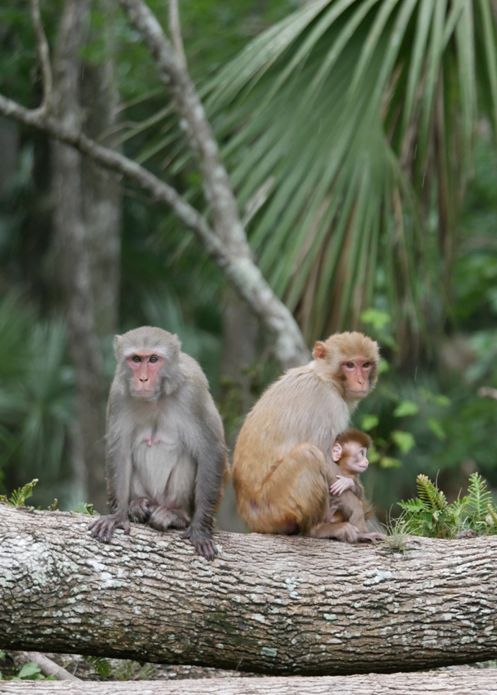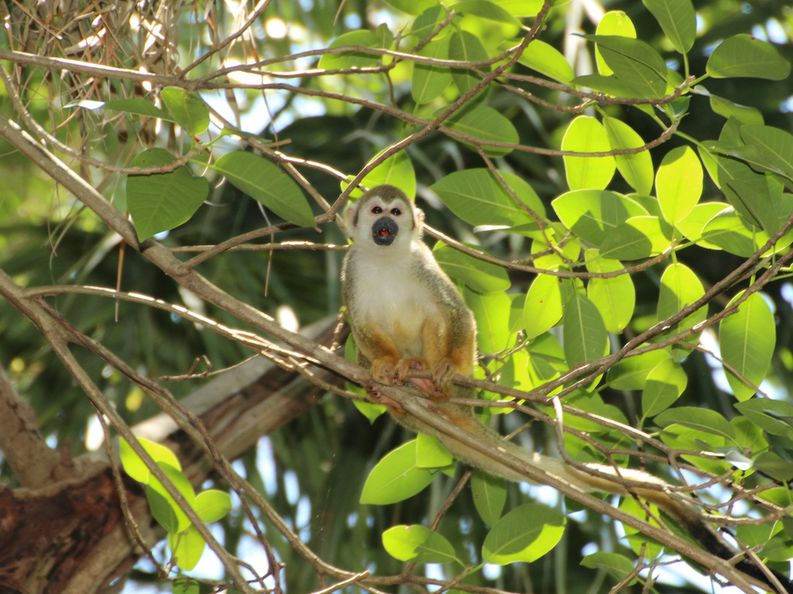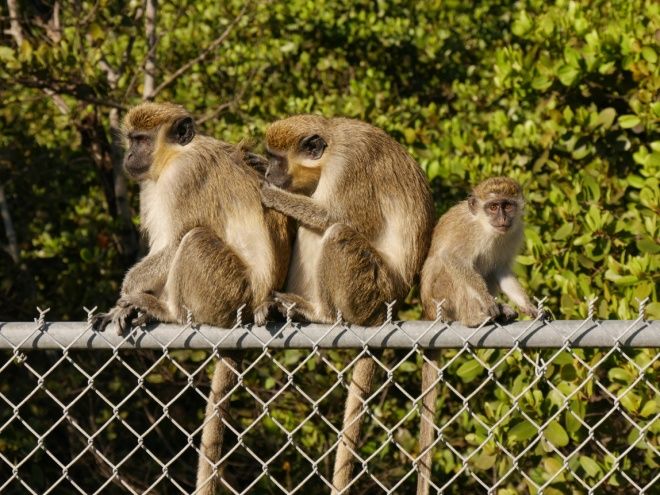Introduction
Nonnative species are those which have been introduced to an area where they do not naturally occur. These introductions may be accidental, such as inadvertent transport through cargo or escapes from captivity, or intentional, such as releases of unwanted pets or introductions of a new species to control pests. Nonnative species are considered invasive when they become established and cause harm to native plants or animals, the environment, or humans.
More than 500 species of nonnative plants and animals have been introduced into Florida; management of these species cost over $500 million annually. Nearly 20 species of mammals have been introduced in Florida. These include five monkey species, three of which have established breeding populations: rhesus macaques (Macaca mulatta), squirrel monkeys (Saimiri spp.), and vervet monkeys (Chlorocebus sabaeus). This publication describes the natural history and introduction history of these three species, which did or currently do, have wild populations in Florida. It also includes information on two locations that support semi-captive populations of spider monkeys and long-tailed macaques. Potential impacts on native Florida ecosystems and people are summarized as well. The intended audience is anyone who is broadly interested in nonnative species and specifically those people who want to know more about the various monkey populations in Florida. While Floridians may enjoy seeing these interesting creatures, it is important to understand how to identify them, safely observe them from a distance, and understand the impacts they may have in Florida.
Rhesus Macaques (Macaca mulatta)
Natural History
Extending from Afghanistan and Pakistan in the west to China and Vietnam in the east, rhesus macaques have the largest native range of any non-human primate. They are both arboreal and terrestrial, splitting their time between trees and the ground. While they are primarily herbivorous, they also eat insects, shellfish, bird eggs, and small vertebrates. They are often considered a pest in their native range, as they frequently raid crops and are a nuisance in urban areas. Wild macaques are typically afraid of humans; however, when fed by humans, they can become aggressive towards people.
Rhesus Macaques in Florida
The first recorded introduction of monkeys in Florida occurred along the Silver River in the 1930s in what is now Silver Springs State Park. A commercial river boat captain, Colonel Tooey, released approximately six rhesus macaques on an island in the Silver River in an effort to increase tourism. Rhesus macaques are excellent swimmers, which allowed them to swim to the forest and begin breeding. By the 1980s, their numbers reached around 400 animals. From 1984–2012, population growth was controlled by trapping and removing macaques; approximately 1,000 macaques were removed from this population by private trappers and sold to biomedical research facilities. This removal effort was very controversial and has since been halted. In 2015, it was estimated there were approximately 175 rhesus macaques among five groups in Silver Springs State Park, and the population was growing. For more information about rhesus macaques at Silver Springs, read this publication https://edis.ifas.ufl.edu/publication/UW412.
In the 1970s, the population along the Silver River expanded to the areas along the Ocklawaha River. A study conducted in 2018 indicated there were a minimum of 134 macaques among six groups living along the Ocklawaha, and that these groups spanned an area at least 20 km (12.4 miles) north and 11 km (6.8 miles) south of where the Silver River flows into the Ocklawaha River. The current number of macaques inhabiting the forests in this area is unknown.

Credit: C. Jane Anderson
Another population of rhesus macaques in Florida was introduced by Charles Rivers Laboratories, a laboratory animal breeding company. The company began stocking rhesus macaques on two islands in the Florida Keys in the 1970s to be used in biomedical research. The company placed 1,383 macaques on Key Lois in 1973, and between 1978 and 1980 moved approximately half the animals to Raccoon Key. Although the company provided the animals with food, the macaques also ate natural vegetation on the islands. They caused significant destruction of mangroves; by the mid-1990s, the macaques were reported to have destroyed 30 acres of mangroves on Key Lois alone. Mangroves are important for preventing shoreline erosion and providing wildlife habitat. In 1997, a judge declared that the company must remove the monkeys from the islands, and the company removed the animals from 1999–2000.
An amusement park called Tropical Wonderland in Titusville was responsible for a third population of rhesus macaques in Florida. When the park closed in 1976, rhesus macaques either escaped or were intentionally released by the park owner. By 1977, between 35 and 75 rhesus macaques were roaming the area, and local residents reported being attacked by the animals. A 1977 newspaper article reported the Florida Fish and Game Commission—now the Florida Fish and Wildlife Conservation Commission (FWC)—planned to trap and remove the animals; it is unclear whether this trapping effort came to fruition. The monkeys were last seen in the area in the early 1990s. It is unclear whether they were trapped and removed or if the animals died of natural causes.
Squirrel Monkeys (Saimiri sp.)
Natural History
Squirrel monkeys are native to Central and South America. There are five species commonly referred to as squirrel monkeys. All five species are small and look very similar to each other. Central American squirrel monkeys occur in Costa Rica and Panama, and South American squirrel monkeys are distributed throughout the Amazon region. Of the five populations of squirrel monkeys that have been introduced in Florida, three have been confirmed to be Saimiri sciureus, one of the four squirrel monkey species from South America. The species of the other two populations are unknown. Squirrel monkeys are arboreal, spending the majority of their time in trees. They primarily consume fruits and insects but will also eat small vertebrates, snails, and crabs.
Squirrel Monkeys in Florida
There have been five populations of squirrel monkeys confirmed in Florida, but only one remains. This existing population is reported to have come from two pairs of squirrel monkeys that were released from a social club and settled in the Bartlett Estate in Ft. Lauderdale, Florida, in the mid-1970s. The monkeys forage on trees, invertebrates, and small vertebrates in the 35-acre property. A 1988 census identified 43 individuals. In the mid-1990s there were approximately 27–30 monkeys on the property. As of 2021, only one monkey remained. It is believed their population decline was the result of particularly cold winters, which the monkeys were unable to survive, and private trappers capturing and removing the animals.
Silver Springs, now home to a large population of rhesus macaques, once had a small number (12–15 individuals) of an unknown species of squirrel monkey. The squirrel monkeys were initially contained in enclosures but were released into the park around 1960. These monkeys were popular with tourists, who liked to hand-feed them. The squirrel monkeys of Silver Springs State Park disappeared by the mid-1970s, possibly pushed out by larger, aggressive rhesus macaques.

Credit: Steve Johnson
Another population of squirrel monkeys once roamed free in Masterpiece Gardens, a tourist attraction near Lake Wales. It’s unclear exactly when or how they were introduced, but records going back to 1971 suggest they were probably introduced sometime during the 1960s. In the early 1980s, the owner of the property attempted to trap and sell the monkeys; it is unknown whether any were actually captured. The last sighting of monkeys in this population occurred in 1989, with cold weather being the most likely cause of their disappearance.
Another population of squirrel monkeys, confirmed to be S. sciureus, lived along the Gordon River in Naples until around 2010. The source and date of the population’s establishment is unknown, but is reported to have been in the 1960s. In the late 1990s and early 2000s, there were reports of people trapping the monkeys, likely for the pet industry or research. Trying to maintain the population, the Naples city council proposed a city ordinance in 2002 to prevent trapping, but it was denied the following year. The population dwindled to three members by 2009, and none have been reported since approximately 2010.
Animal rights activists released a colony of about 65 captive squirrel monkeys on the Florida Atlantic University campus in 1970. The monkeys lived on campus until 1976, when the last three individuals were reported. It is unknown why this population did not survive.
Vervet Monkeys (Chlorocebus sabaeus)
Natural History
The six species of the genus Chlorocebus are commonly referred to as vervet monkeys. Vervet monkeys are native to a variety of habitats throughout sub-Saharan Africa. They spend their days foraging and traveling on the ground and sleep in trees at night. They are considered to have one of the most omnivorous diets of all primates, consuming a wide variety of plants, fruits, small vertebrates, and bird eggs.
Vervet Monkeys in Florida
Vervet monkeys were introduced into Dania Beach, south of Ft. Lauderdale, in the 1940s. These animals escaped from the Anthropoid Ape Research Foundation, a facility that imported primates from Africa for use in biomedical research. Previous research suggested the species established in Florida was Chlorocebus aethiops, but recent DNA research found it is actually Chlorocebus sabeus, a species native to West Africa. A study conducted in the early 1990s estimated there were 36 vervet monkeys split between two groups. A 2020 census indicated there were 40 vervet monkeys split among four groups.
The similar population sizes from the early 1990s and census data from 2014–2020 suggest there is limited growth in this population.The reason for this apparent population stability is being studied by primatologists.
In 2013, two vervet monkeys separated from the main population in Dania Beach and moved south into Miami-Dade County. About 33 miles south of Dania Beach, FWC trapped a vervet monkey believed to be one of the separated individuals and placed it in captivity; the fate of the other animal is unknown. There has been no official effort to control the vervet monkey population, though there were reports of private trappers capturing them in the early 1990s and early 2000s. The animals in this population are extremely habituated to humans and are regularly fed. The city of Dania Beach passed an ordinance in 1993 prohibiting the feeding of monkeys, but it is not regularly enforced.

Credit: C. Jane Anderson
Semi-Captive Monkeys in Florida
There are two known locations in Florida that hold monkeys in semi-captive enclosures. Homosassa Riverside Resort owns an island in the Homosassa River. As of 2021, there were 4 spider monkeys (genus Ateles) on the island. Previously the island also included two squirrel monkeys, which died of natural causes. The island was initially planted with palm trees, but foraging by the monkeys caused the palm trees to die. The island is now planted with cedar trees.
In 1933, Joseph DuMond introduced six long-tailed macaques (Macaca fascicularis) into a dense forested area near Miami; he intended to study how the animals adapted to a new environment. He later moved them into a fenced enclosure, which became a tourist attraction and nature center known as Monkey Jungle; programs in this facility are managed by the 501(c)3 affiliate, the DuMond Conservancy. As of 2021 the facility housed nine species of primates. Most were kept in fully enclosed exhibits. However, three species—long-tailed macaques, squirrel monkeys (Saimiri boliviensis peruviensis), and brown-tufted capuchins (Sapajus apella)—were kept in semi-captive enclosures; these enclosures have tall, electrified fences that lack roofs. In 2021, there were approximately 110 long-tailed macaques in the facility, all descendants of the original six animals.
Potential Impacts of Monkeys in Florida
Invasive species significantly affect native ecosystems. The invaders can directly prey on native species or compete with them for food and other resources. Introduced monkeys have the potential to negatively affect both Florida’s ecosystems and its people. The impacts of introduced species can be difficult to identify or quantify, so continued monitoring is important.
Squirrel monkeys have had limited success in Florida and are therefore the least likely of the three monkey species to significantly affect native plants or wildlife. Cold winters appear to have served as population control and kept squirrel monkey populations from thriving. However, some populations persisted for a few decades. Squirrel monkeys eat lizards and bird eggs, and there was a report of a squirrel monkey in Florida eating a bat. They may, therefore, influence native species through direct predation.
The vervet monkey population has remained stable for several decades, indicating they are capable of reproducing and persisting in Florida. Vervet monkeys cause economic loss by crop raiding in their native African range and on Caribbean islands where they are introduced. To date, no negative impacts have been reported from the vervet monkey population in Florida, but it is important for researchers to continue monitoring this population.
Rhesus macaques pose the greatest ecological and human health threats of the monkeys in Florida. As previously mentioned, they were removed from the Florida Keys after destroying mangroves. Rhesus macaques in Silver Springs State Park consumed quail eggs when they found them in artificial bird nests placed by researchers, indicating the macaques may be a threat to breeding birds in the area. Invasive rhesus macaques in Puerto Rico have decreased bird populations by eating their eggs and have caused millions of dollars in damage by raiding crops.
Rhesus macaques can also threaten human health. Rhesus macaques are maintained on Morgan Island, South Carolina, for research; tidal creeks around this island have been found to have elevated levels of E. coli and fecal coliform bacteria as a result of the macaques. In their native range, rhesus macaques are regarded as sacred by many people, but they are also considered a nuisance and threat to human health and livelihood. Macaques accustomed to being fed lose their fear of humans and begin to see humans as a food source. As a result, the macaques may become aggressive, attacking humans when food is around. In parts of their native range, scratches and bites are fairly common when humans encounter habituated macaques; thus, caution should be exercised when encountering them in the wild in Florida. Feeding wild monkeys in Florida is prohibited by Florida law. The Florida Fish and Wildlife Conservation Commission (Florida’s wildlife agency) defines feeding as “placing food or garbage, allowing the placement of food or garbage, or offering food or garbage in a manner that attracts wild monkeys". Rhesus macaques, including the population in Silver Springs State Park, are known to carry the herpes B virus. This virus, which is usually asymptomatic in macaques, is transmitted through bodily fluids (e.g., saliva, feces). There are several documented cases of this virus spreading to humans in laboratory settings, but there are no reports of a person contracting it from a wild monkey. Additional research is needed to understand why this is the case, but it’s essential to keep a safe distance from macaques. Herpes B has a high fatality rate when it is transmitted to humans. Anyone bitten or scratched by a macaque should seek immediate medical care and follow the guidelines provided by the Center for Disease Control: http://www.cdc.gov/herpesbvirus/firstaid-treatment.html.
Conclusions
Monkeys are interesting animals, and many people enjoy watching and interacting with them. It is important to remember, however, they are not native to Florida, and unmanaged populations could potentially be dangerous for the environment, native wildlife, or humans. Continued research is very important to determine the best way to monitor and manage Florida’s monkey populations.
Recommended Readings and Online Resources
Anderson, C. J., M. van de Kerk, W. E. Pine, M. E. Hostetler, D. J. Heard, and S. A. Johnson. 2019. “Population Estimate and Management Options for Introduced Rhesus Macaques.” Journal of Wildlife Management 83 (2): 295–303.
Anderson, C. J., M. E. Hostetler, and S. A. Johnson. 2017. “History and Status of Introduced Non-Human Primate Populations in Florida.” Southeastern Naturalist 16 (1): 19–36.
Anderson, C. J., D. J. Heard, M. A. Andreu, M. E. Hostetler, and S. A. Johnson. 2017. “Winter Home Range and Habitat Selection of an Introduced Rhesus Macaque Group (Macaca mulatta) in Silver Springs State Park.” Florida Scientist 80 (4): 159–164.
Anderson, C. J., M. E. Hostetler, and S. A. Johnson. 2016. “History and Status of Introduced Rhesus Macaques (Macaca mulatta) in Silver Springs State Park, Florida.” WEC367/UW412, 05/2016. EDIS 2016. https://edis.ifas.ufl.edu/publication/UW412
Anderson, C. J., M. E. Hostetler, K. E. Sieving, and S. A. Johnson. 2016. “Predation of Artificial Nests by Introduced Rhesus Macaques (Macaca mulatta) in Central Florida, USA.” Biological Invasions 18 (10): 2783–2789.
DuMond Conservancy for Primates and Tropical Forests. 2016. Research. https://dumondconservancy.org/
Hyler, W. H. 1995. “Vervet Monkeys in the Mangrove Ecosystems of Southeastern Florida—Preliminary Census and Ecological Data.” Florida Scientist 38–43.
Iannone, B. V., E. C. Bell, S. Carnevale, J. E. Hill, J. McConnell, M. Main, S. F. Enloe, S. A. Johnson, J. P. Cuda, S. M. Baker, and M. Andreu. 2021. “Standardized Invasive Species Terminology for Effective Outreach Education.” FOR730/FR439, 8/2021. EDIS 2021 (4):8 https://doi.org/10.32473/edis-fr439-2021
Kruer, C. 1996. “The Inside Story on the Monkey Islands of the Florida Keys.” The Florida Naturalist 68:10.
Leon, B. S. 1997. Behavioral Ecology of an Urban Troop of Squirrel Monkeys. Thesis, San Diego State University, San Diego, California, USA.
Williams, D. M. 2017. “Census and Local Tolerance of Chlorocebus sabaeus in Dania Beach, Florida.” Paper presented at the 3rd Annual South Florida Primatology Meeting, Loxahatchee, Florida.
Williams, D. M., S. M. Almanza, I. Sifuentes-Romero, and S. M. Detwiler. 2021. “The History, Taxonomy, and Geographic Origins of an Introduced African Monkey in the Southeastern United States.” Primates 62:617–627.
Wisely, S. E., K. Sayler, C. J. Anderson, C. Boyce, A. R. Klegarth, and S. A. Johnson. “Antibody Prevalence and Detection of Viral Shedding of Macacacine herpesvirus 1 in Invasive Rhesus Macaques (Macaca mulatta) in a Public Park, Florida, USA.” Emerging Infectious Diseases 24 (2): 345–351.
Wolfe, L. D., and E. H. Peters. 1987. “History of The Freeranging Rhesus Monkeys (Macaca mulatta) of Silver Springs.” Florida Scientist 4:234–245.